Fifth in a series of interviews with participants at the 2009 Association of Tropical Biology and Conservation (ATBC) conference.
One of the most pressing issues in the conservation today is how climate change will affect tropical ecosystems. The short answer is: we don’t know. Because of this, more and more scientists are looking at the probable impacts of a warmer world on the Earth’s most vibrant and biodiverse ecosystems.
Kenneth J. Feeley, tropical ecologist and new professor at Florida International University and the Center for Tropical Plant Conservation at the Fairchild Tropical Botanic Garden, is conducting groundbreaking research in the tropical forests of Peru on the migration of tree species due to climate change.
“I have found that most of the species we have looked at are in fact shifting their distributions, or migrating, upslope as predicted under warming temperatures. In one sense this is very positive in that it shows that these species could respond to climate change and that they may be able to persist,” Feeley told Mongabay.com.
 Feeley standing above treeline in the Andes of Peru looking down into a valley that has been largely converted over to agriculture. Photo courtesy of Kenneth J. Feeley. |
However the news is not all good: “on the negative side we find that species are not shifting their distributions as fast as predicted under the temperature changes and thus may experience a decrease in habitat area.”
But like everything in the tropics, the answer is never simple. Another factor, explains Feeley, is that even if tree species are able to migrate upslope, eventually they will hit areas of human impact, such as grazing livestock or frequent burning. Feeley calls this human-created barrier in the Andes the ‘grass ceiling’.
“In the context of climate change, [human disturbances] can prevent species from moving by cutting off the corridors between current and future habitat areas. With shifting species distributions it becomes increasingly important that we protect more habitat since we don’t know where species are going to end up and that we maximize connectivity between protected areas to allow for species migrations,” says Feeley.
While Feeley is reluctant to enter a numbers game—and rightfully so—about how many species may be lost, he does say that it will be “too many”.
“As I have tried to stress in this interview and in some of my writings, the threats to tropical forests are many and complex and we are still lacking the most basic data needed to have any confidence in the predictions that we make,” Feeley says, adding that, “I do believe that most species are fairly resilient and that most could survive climate change if not for the additional pressures of human land use.”
 A view of the mountain with cloud cover. Photo by Kenneth J. Feeley. |
Feeley says that conservationists should not focus solely on just climate change or deforestation, but both need to be tackled if tropical species are to have a good chance of survival.
“Climate change and deforestation are both happening and it is impossible to separate out the effects,” Feeley says. “With changing climate many species will be forced to migrate but deforestation may cutoff migration corridors.” He adds that wildfires may become one of the largest threats to
tropical forests in warmer and more fragmented conditions.: “Wildfires will be more common and more severe if climate change results in dryer conditions as is predicted under many models.”
In a September 2009 interview, Mongabay.com spoke with Feeley about migrating tropical tree species, the resilience of tree species to higher temperatures, the combined threat of climate change and human impact on tropical species, and the possible tropical forest of the future.
INTERVIEW WITH KENNETH J. FEELEY
Mongabay: What is your background?
Kenneth J. Feeley: I grew up in the suburbs of Atlanta and while I spent a lot of time outdoors hiking and backpacking, I never got out of country and much less into the tropics until my junior year at Wake Forest University when I did a semester abroad in Monteverde Costa Rica. Although this course had me fairly well convinced that my future was in tropical forest ecology, I wanted to get some more experience, so after graduating I worked as a research assistant on several different projects including in the Smokey Mountains National Park, in the salt marshes of Sapelo island Georgia, and for seven months living with just one other person studying seabirds on an island in the Galapagos. None of these experiences changed my mind so when it came time to apply to graduate school, my first choice of advisors was John Terborgh who literally wrote the text book on tropical ecology.
 Peru’s cloud forest. Photo by Josh Rapp. |
Under John’s tutelage I spent most of my time working on a set of recently isolated landbridge islands in Lago Guri, Venezuela. Lago Guri is an amazing multi-billion dollar unintentional ecological experiment that provided me the ideal model system for looking at the effects of fragmentation and the importance of trophic dynamics in regulating tropical communities. After finishing my work at Lago Guri and getting my degree from Duke University, I went on to do a postdoc at Harvard University with the Center for Tropical Forest Science, the organization that runs the BCI 50 hectare plot and many other 50 hectare plots around the world. Working with the CTFS forced me to hone my statistical skills and expanded my interest in
large-scale macroecological questions. The CTFS also gave me a chance to visit the rainforest of Southeast Asia, greatly expanding my world view.
After Harvard and the CTFS I did a second postdoc with the Andes Biodiversity and Ecosystem Research Group, working with Miles Silman at Wake Forest University. My research with the Andes Group took advantage of a wonderful system of treeplots that they have set up along an elevational gradient in Peru to look at the effects of climate change on tropical montane forests. In addition to field work in Peru I also indulged my statistical side and worked on several global and continental-scale studies using databases of herbarium collections available online to estimate species ranges and predict the effects of climate change and deforestation.
Two weeks ago I moved on to the next stage of my career and started a faculty appointment with the Department of Biological Sciences at Florida International University and the Center for Tropical Plant Conservation at the Fairchild Tropical Botanic Garden in Miami. FIU and the Fairchild are ideal places for me to base my work given their geographic proximity to the tropics and the resources available to me.
Mongabay: How did you become interested in tropical plants?
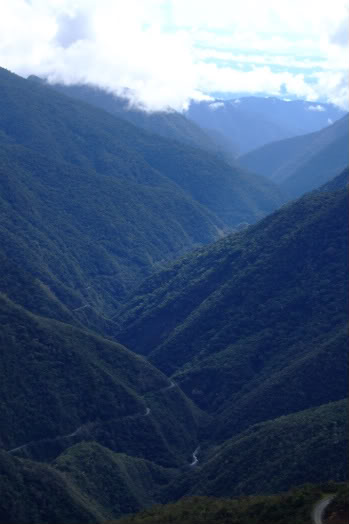 Looking down the Kosnipata Valley. Photo by Kenneth J. Feeley. |
Kenneth J. Feeley: Honestly when I started graduate school at Duke I had zero interest in plants and started a project looking at the effect of fragmentation on birds in Lago Guri. But I remember that every time I saw Nigel Pitman, who was one of my lab mates, he would invariably ask me, “So, have you switched to plants yet?” I always found this question rather annoying since I had no interest in switching to plants and especially since Nigel is a very quiet person and this was usually the entire extent of our conversation. But as I progressed in my project I realized that the only way to understand what the birds were doing was to understand what the plants were doing, and vice versa. You could call this my awakening as an ecologist – the realization that everything really is interconnected and interdependent. So towards the end of my graduate studies I reluctantly conceded to Nigel that I had in fact switched to plants, at least in part.
In my work, I have since always tried to take a more complete view of ecosystems, looking both at the plants and animals. For one reason or another though my work has begun to get more and more focused on the plants. I think that this is mostly due to the fact that I have become increasingly interested in the study of larger-scale phenomenon which involves the analyses of very large datasets, the vast majority of which are available exclusively for plants. That said, I have not put the blinders on and always try to keep in mind that the flora cannot exist independent of the fauna. The empty forest syndrome is a real danger and is a threat that we can never forget in conservation planning.
Mongabay: You’ve worked in many places in the tropics—do you have a favorite?
Kenneth J. Feeley: I have worked in a lot of different habitats in a lot of different counties throughout the tropics and they all have something special to offer. But if forced to choose I would say that my favorite place must be Manu National Park in southeastern Peru. Beyond the diversity of animals and plants that Manu is famous for, the park also offers an amazing diversify of habitats. In a single day, you can travel though the park and go from highland pajanal above treeline at 3500 meters, descend through cloud forest and low montane forest to the lowlands around Cocha Cashu Biological Station. To traverse these habitats is an amazing experience and one that I have enjoyed several times working in Manu.
Mongabay: You are currently researching how tropical tree species are responding to climate change, why is this important?
Kenneth J. Feeley: We can protect tropical forests from most human disturbances such as logging and hunting, for example by setting up parks, but we simply cannot protect forests from climate change – climate change is a global disturbance, the effects of which will be felt even in the most remote, best protected, and most pristine forests in the world. Therefore, it is of utmost importance that we understand how species are responding, and will respond, to climate change if we hope to mitigate species loss.
MIGRATION OF TREES IN THE TROPICAL ANDES
Mongabay: What makes your site in Peru perfect for studying tropical plants reaction to global climate change?
  Top: looking down the Kosnipata ridge in Manu National Park where the transect of plots is located. Bottom: The same pictures but with the locations of some of the study plots superimposed. Photos by Kenneth J. Feeley. |
Kenneth J. Feeley: Where I am working in Peru is in many ways a model system, or natural laboratory for studying climate change. I am working in a series of 1-hectare treeplots established by Miles
Silman and the Andes Biodiversity and Ecosystem Research Group in the Kosnipata Valley in Manu Park. These plots were set up at intervals of 250 vertical meters along a ridge descending approximately 2000 meters from treeline, down through cloudforest to lower montane forests. Given the strong relationship between temperature and elevation (temperature decreases 5.5oC for every 1000 meters you ascend) these plots span a huge range of climates, essentially allowing us to do space for time substitutions and predict the fate of these various forests under future climate scenarios.
Mongabay: There have been many studies of plant movements to climate change in temperate zones. Why has it taken so long for a similar study in the tropics? What are the particular challenges in mapping tropical tree movements in response to climate change?
Kenneth J. Feeley: Before we can predict where species will be in the future we need to know where they are now. But the honest truth is that we simply don’t have the faintest idea where most tropical species occur. For plants, which are the best studied group of organisms, most tropical species are known from only 1 or 2 collections! Given this paucity of data we cannot reliably map where species occur and we cannot even begin to guess at the factors that determine where they occur. As such we have no hope of predicting where they will occur under a future climate. Throw on top of this the fact that climate change is not working in isolation but in a context of human land use change and the problem becomes near insurmountable.
Mongabay: In your study you have followed the migration of tree species in the tropics due to climate change. What are your findings? Are trees moving quickly enough?
Kenneth J. Feeley: In my studies of Andean forests, I have found that most of the species we have looked at are in fact shifting their distributions, or migrating, upslope as predicted under warming temperatures. In one sense this is very positive in that it shows that these species could respond to climate change and that they may be able to persist. And actually in this specific system upslope migrations have the potential to be very positive since many species may increase the amount of land area available to them as they expand onto the large expanses of relatively flat terrain above treeline. But on the negative side we find that species are not shifting their distributions as fast as predicted under the temperature changes and thus may experience a decrease in habitat area as the lower portions of their ranges become unsuitable but they fail to gain new habitat upslope. And making matters worse we have reason to believe that in the Andes treeline is set by human activities such as cattle grazing and burning which means that treeline will not sift upslope thereby creating what I call the “grass ceiling” and preventing species from moving up onto the high plains.
Mongabay: How does human disturbance of tropical forests complicate the ability of trees to move quickly enough and far enough to survive in a changing climate?
 At around 3500 meters showing treeline. Photo by: Josh Rapp. |
Kenneth J. Feeley: Human land use can reduce the amount of habitat currently available to species and it can reduce the amount of habitat that will be available to them in the future. But perhaps most importantly, in the context of climate change, it can prevent species from moving by cutting off the corridors between current and future habitat areas. With shifting species distributions it becomes increasingly important that we protect more habitat since we don’t know where species are going to end up and that we maximize connectivity between protected areas to allow for species migrations.
Mongabay: Would you recommend assisted migration efforts as a way to save tropical tree species?
Kenneth J. Feeley: Assisted migration is a sticky topic. In general I am against it. I think that the potential costs outweigh the potential benefits. Even under the best case scenario we will only be able to move a small handful of select special interest species, but by moving this small handful of species we may disrupt entire ecosystems, potentially causing extinctions of massive numbers of species.
SURVIVAL OR EXTINCTION: TROPICAL TREES
Mongabay: Can you explain the term ‘biotic attrition’ to us?
Kenneth J. Feeley: Biotic attrition is simply the loss of diversity that happens when the number of species emigrating from an area due to climate change exceeds the number immigrating into that area
Mongabay: How do scientists know what temperatures tropical trees can survive in?
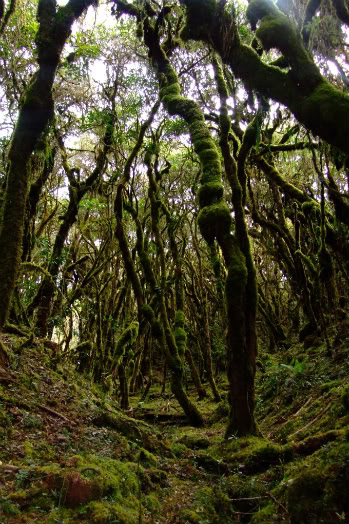 Inside the cloudforest. Photo by: Kenneth J. Feeley. |
Kenneth J. Feeley: We don’t. We try to guess at what range of temperatures trees can survive in by looking at the range of temperatures over which a species now occurs. This method assumes that we know species’ true distributions and that those distributions are set by just temperature and not other factors
such as rainfall, soil, or species interactions. In other words a species may be able to occur at temperature x but only if precipitation is y mm per year. Or maybe a species never occurs at temperature x but in fact it could survive perfectly fine at that temperature if it found the right soil conditions. Ideally we would conduct detailed physiological experiments to determine species responses to temperature under controlled conditions but this is just not feasible in the tropics given the vast number of species – many of which are rare – and the difficulty in conducting these sorts of studies across life stages, for example on long-lived emergent trees.
Mongabay: Why might tropical trees survive hotter temperatures than usually predicted by observation?
Kenneth J. Feeley: Many tropical tree species have experienced hotter temperatures in their evolutionary past and it is possible that they have not lost the ability to persist under hotter conditions. The question then becomes, “if species can occur at hotter temperatures, why don’t they?” For many species the answer may simply be that that there are no hotter areas currently available. For example, I have found that many of the plant species that grow in the hottest parts of the Amazon have very reduced thermal ranges, occurring only over a very small range of temperatures – much less than their “colder” counterparts. One hypothesis is that these species’ thermal ranges are not truly reduced but instead that these species cannot fully realize their thermal ranges due to the fact that there simply are no hotter areas in South America where they can occur. If this is the case, then as temperatures warm, these species will not simply shift their distributions upslope as predicted under simple models but instead they will shift the upper edges of their distributions upslope and maintain their lower hotter edges where they are, thereby expanding their ranges. If this happens, biotic attrition in the lowland hot tropics will be reduced.
Mongabay: If observed temperatures are accurate what will happen to tropical forests if climate change raises temperatures in the region by 5 degrees Celsius? How about if such observations have been wrong?
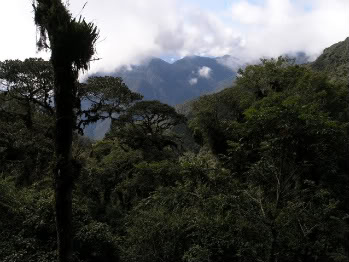 View of cloudforest’s canopy. Photo by Josh Rapp. |
Kenneth J. Feeley: One simple model of how species will respond to climate change is by changing their distributions to stay within their preferred climatic envelope. If the temperature goes up species will move around to stay within their preferred temperature limits. In most cases this means moving upslope since temperatures are colder at higher temperatures. In the Amazon, this could result in massive biotic attrition meaning basically that all the species move upslope and there are no species available from hotter areas to replace them. Basically in a very cartoon-like model we would move all species up and the Amazon would be left with zero species – a biological desert. But many species may in fact be capable of persisting under greater temperatures due to greater than observed thermal niches or due to changes in precipitation. But even if species don’t move in response to climate change, warming will still be a threat since it can increase flammability and the risk of fire. Fire is a huge but underappreciated danger in tropical forests. If fire frequency and or intensity increases due to warming we may potentially lose vast numbers of species.
Mongabay: Under a best-case-scenario what percentage of tree species will the tropics likely lose if climate change is not mitigated?
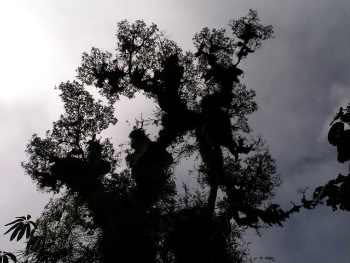 Cloudforest tree. Photo by: Josh Rapp. |
Kenneth J. Feeley: I will avoid giving any estimates of the number or percentages of species threatened and just say that it will certainly be too many. As I have tried to stress in this interview and in some of my writings, the threats to tropical forests are many and complex and we are still lacking the most basic data needed to have any confidence in the predictions that we make. I do believe that most species are fairly resilient and that most could survive climate change if not for the additional pressures of human land use. If we are intelligent and use the land responsibly and in such a way that allows species to respond to climate change, then we still may be able to preserve a great deal of tropical biodiversity.
Mongabay: Given your findings, which would you say is a greater threat to the tropics: climate change or deforestation?
Kenneth J. Feeley: The real answer is climate change AND deforestation. Climate change and deforestation are both happening and it is impossible to separate out the effects. With changing climate many species will be forced to migrate but deforestation may cutoff migration corridors. One of the biggest dangers of deforestation is wildfires. Wildfires will be more common and more severe if climate change results in dryer conditions as is predicted under many models. It is important that we realize the connections and synergies between climate change and land use change if we make any real progress towards protecting tropical biodiversity.
Mongabay: In the face of climate change and human impact, how much hope do you have for the tropical forests of South America?
Kenneth J. Feeley: We will always have tropical forests but they will not be the same that we have now. Future visitors to the tropic will certainly be awed by the forests’ majesty and grandeur but only because they will not know what they are missing.
Related articles
Fire contributes 20% of global warming emissions
(04/23/2009) Fire accounts for roughly half of greenhouse gas emissions from deforestation and about twenty percent of total emissions from human activities, report researchers writing in the journal Science. The estimates — based on analysis of fire’s impact on emissions of carbon dioxide, nitrous oxide, and methane; albedo or the reflectivity of Earth’s surface; and release of aerosols and other particulates — suggest fire plays a major large role in climate than conventionally believed.
Global warming could turn forests from sink to source of carbon emissions
(04/16/2009) Rising temperatures could reverse the role forests play in mitigating climate change, turning them into net sources of greenhouse gases, reports a new assessment by the International Union of Forest Research Organizations (IUFRO). The report, titled “Adaptation of Forests and People to Climate Change – A Global Assessment” and authored by 35 forestry scientists, examined the potential impacts of climate change across the world’s major forest types as well as the capacity of forest biomes to adapt to climate shifts. Among the conclusions: a 2.5-degree-C rise in temperatures would eliminate the net carbon sequestering function of global forests. Presently forests worldwide capture about a quarter of carbon emissions.
Trees in trouble: massive die-offs predicted with global warming
(04/13/2009) An experimental study of pinon pines at Biosphere 2 in Arizona shows that an increase in temperature makes the species more susceptible to die-off during drought. When temperatures were increased by 4 degrees Celsius (7.2 degrees Fahrenheit), the piñon pines died 28 percent faster than trees which experienced drought-conditions at current temperatures, according to a new study published in Proceedings of the National Academy of Sciences (PNAS).
Plant communities changing across the globe, says scientist Sasha Wright
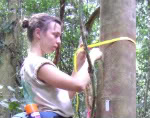
(03/29/2009) Having studied plant communities across three continent and within widely varied ecosystems—lowland tropics, deciduous forests, grasslands, and enclosed ecosystems on hill-tops—graduate student Sasha Wright has gained a unique understanding of shifts in plant communities worldwide as they respond to pressures from land use and global climate change. “Plant communities are certainly changing,” Wright told Mongabay.com in a March 2009 interview. “These changes are undoubtedly affected by an increased occurrence of extreme weather events, temperature fluctuations, atmospheric CO2 concentrations, human land use, and in some cases urbanization of populations.”
Monstrous prehistoric snake provides glimpse of warmer tropical forests
(02/04/2009) On Wednesday scientists announced the discovery of the world’s largest snake, a prehistoric beast which preyed on giant turtles and crocodile-like reptiles in South America after the demise of the dinosaurs. As amazing as the discovery is, its greatest importance may be the clues it provides conservationists about the future of tropical forests under various global warming scenarios.
What is the greatest threat to rainforests: habitat destruction or climate change?
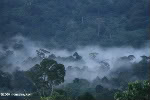
(01/13/2009) A symposium from the Smithsonian Institution meant to debate the level of threat by deforestation posed to the tropics shifted topic slightly near its end as scientists began to discus which was the most significant threat for rainforests and the species that inhabit them: habitat destruction or climate change?
Climate change will damage forests, creating hardship for rural communities
(11/28/2008) Climate change will transform forests that directly sustain nearly one billion people, warns a report to be released next week at the United Nations Framework Convention on Climate Change (UNFCCC) meeting in Poznán, Poland.
Rainforest biodiversity at risk from global warming
(10/09/2008) Climbing temperatures may doom many tropical species to extinction if they are unable to migrate to higher elevations or cooler latitudes, report researchers writing in Science.